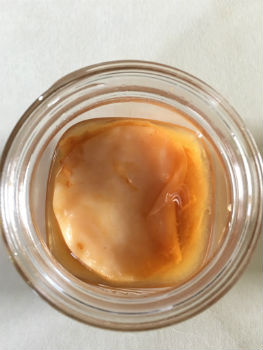 Most of us have probably heard of Kombucha Tea, made from fermented sweet tea. We make and drink it regularly (and it makes awesome cocktails). We also make milk and water kefir, two other probiotic and delicious beverages. After allowing it to languish in a cupboard for a year (really!), we pulled the Jun scoby out and re-started it.
Most of us have probably heard of Kombucha Tea, made from fermented sweet tea. We make and drink it regularly (and it makes awesome cocktails). We also make milk and water kefir, two other probiotic and delicious beverages. After allowing it to languish in a cupboard for a year (really!), we pulled the Jun scoby out and re-started it.
Jun tea, while similar to kombucha in some ways, is a distinctly different beverage. While kombucha is made with black or green tea (or a combination of these), sweetened with sugar, and fermented using finished kombucha tea from a previous batch plus the kombucha scoby, jun is made from green tea only, sweetened only with raw honey. A “mother” (scoby) is also floated in the brew. Jun, though, has a much shorter fermentation window – a few days to a week – whereas we let our kombucha ferment for two full weeks in the first ferment, followed by four additional days in the second ferment.
So you may be wondering why the jun scoby was relegated to a dark cupboard…in two words: cat pee. We made several batches of jun when we first acquired the scoby and each smelled like cat pee. No one (well, most people) don’t want to drink a beverage that reeks of cat pee, so we put the scoby in a jar, poured in a little finished (cat pee) jun, screwed on the lid, and stuck it in the cupboard.
Unexpectedly, that scoby grew. It created thin mini-scoby layers atop the original. It grew so thick with scobies it filled the jar. Impressive. With an entity that determined to live, we had to bring it out and try again. It also supported the theory that jun is an anaerobic ferment, since that jar was sealed tight.
This time, we made two batches, using different green teas. We also used different raw honey. Today is day 6 and both jars appear to have new baby scobies growing at the surface. Neither really smells like cat pee, either. Why jun, when we make all those other ferments? Jun is supposed to contain different probiotics, so why not cover as many bases as possible and keep our gut flora diverse and happy? Raw honey can reportedly help with allergies.
 We tasted each batch of jun today to ensure it’s moving along in its fermentation journey, and while mild-flavored and still a bit too sweet, it tastes good this time – both batches! In addition, the batches are mold-free and are growing new scobies at the surface. Right on track! We’ll give them another couple of days, taste again, and if they’re ready, move them to second fermentation.
We tasted each batch of jun today to ensure it’s moving along in its fermentation journey, and while mild-flavored and still a bit too sweet, it tastes good this time – both batches! In addition, the batches are mold-free and are growing new scobies at the surface. Right on track! We’ll give them another couple of days, taste again, and if they’re ready, move them to second fermentation.
